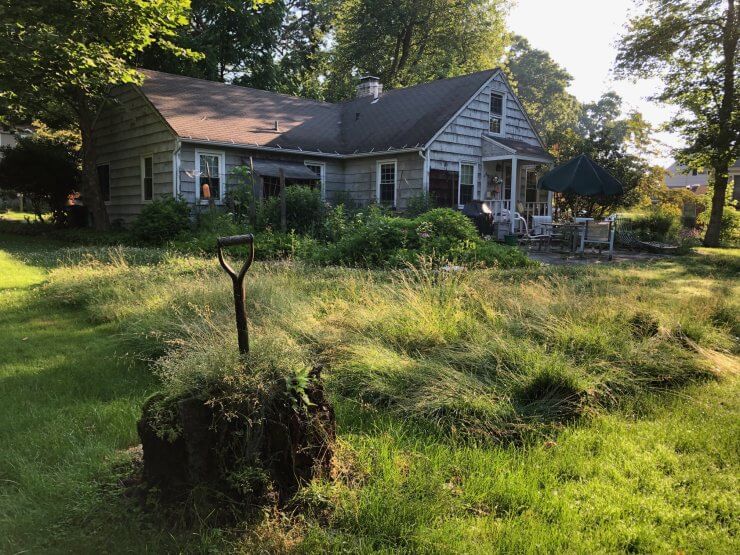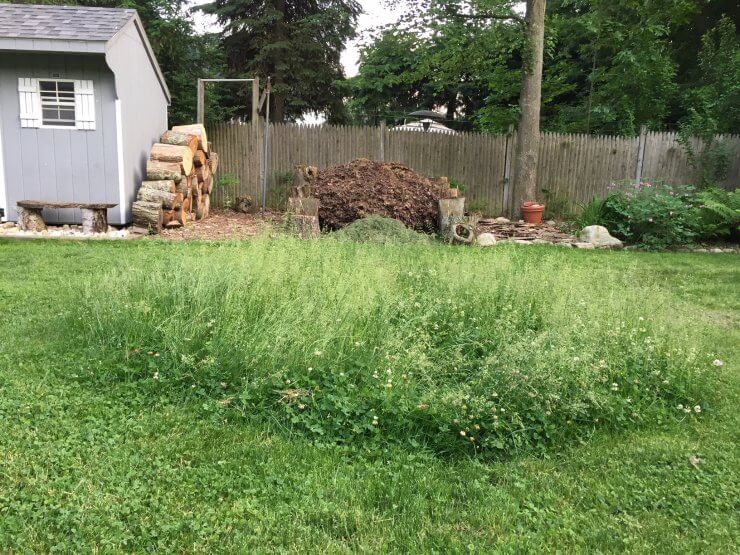
It’s the middle of May, and my backyard compost pile here in southern Connecticut is now fully six months old. As much as the first half of its life was dominated by dead brown leaves, the race to its fruition as finished humus will now be driven by mass infusions of hot green grass clippings.
Today, a Sunday, is the day I mow the lawn and add its surplus trimmings of minced grass to the heap. Today marks a tectonic shift for my pile, in shape and composition.
Discover 7 top tips for growing, harvesting, and enjoying tomatoes from your home garden—when you access the FREE guide The Best Way to Grow Tomatoes, right now!
A suburban backyard is by its nature a passive, back-of-mind kind of place. But sometimes, like this week, which is unfolding with the full bloom of spring, it demands attention. After days of drizzly rain, the sun now fills a cloudless sky, kick-starting the greenest of growth across the landscape. The leaves on the maples have burst out, the garden ferns unfolded, and the grass is thickening and surging upward. They say you can almost see some types of grasses, like bamboo or switchgrass, grow in real time. Right now, that seems true of my lawn.
Aside from learning how to throw a ball, ride a bike, swim, and perhaps read, I’ve been mowing as long as any other thing I’ve mastered. I jumped at the chance to show my dad I was big enough to take over mowing duties for him as a kid and, as I grew older, made spending money by taking care of neighbors’ lawns. Mowing was my first job, and it probably will be my last.
I haul the old Toro mower from the saltbox shed and set it in a patch of sunlight to warm the engine block, a trick that seems to help it start better. I last used the mower in late November to mulch the final leaves of fall, and I cross my fingers that it will start up. A check of the gas tank finds it half full, and I worry whether the gas has gone bad. But the engine revs to life after a few tugs on the starter cord, and off I go.
Mowing is a simple, rewarding task. It’s a fair way to get some sun and some exercise, especially if you never bother to fix the belt that once self-propelled the rear heels. Though it is now just dead weight, I wheel my trusty red Toro around the yard like a matador, raising the front wheels just so to skim an exposed root or pass along a rock border to protect the whirring blade without having to edge with the hand shears or electric trimmer.

Walking behind a mower leads one down interesting paths of thought. Just ask Forrest Gump. It’s a rolling Buddhist prayer wheel of a meditative act, a squared-off labyrinth that leads to a vanishing point as the final strip of ankle-high grass gives way to a uniform plane of green etched by the tracks of the mower wheels. I always feel better about myself after I’ve finished mowing the lawn.
Many gardeners fret about giving over precious backyard space to turf—and I agree—but what lawn I keep is as well-trod as center field at Fenway Park—by the dog and me playing our constant game of fetch, and before that by tossing a baseball, football, or Frisbee to my son. Close-cropped grass makes all the difference; the ball bounces high and true, our footfalls are firm, and no doubt the robins have better luck procuring worms for their chicks.
The only exceptions are a set of patches in the middle of the lawn I leave to thrive as micro-meadows. Two of these are thick with clover, for the bees; the other is a particularly fetching swath of fescue fast going to seed, a visual treat for me. As I let most of the plantings in my yard come to fruition, it seems only fair to allow this bit of turf to do the same.
Having skirted the patches of clover, I mow around the mini meadow of uncut grass. The grass ripening to hay stands out like a bouquet on a tabletop and makes the cut grass that surrounds it look all the more manicured. At least to my eye; my across-the-street neighbor has told me some other neighbors have been wondering what’s up with my yard and its rewilded look. But I like how, especially at dusk, the slanting sunlight passes through their stems and highlights the seedheads.
A vision of amber waves of grain is deeply ingrained in the American psyche. I imagine the fireflies as well appreciate not having a mower running roughshod over their turf; my yard has become the go-to place for the neighborhood kids to chase after fireflies each July. I will cut the mini-meadows after the clover flowers have faded and I’ve harvested a few fistfuls of grass seed, but for now they stand as symbols, exclamation points, really, of pastoral nature left to be.
Last summer I didn’t mow this patch of lawn until September, allowing it to turn all the way to hay. Now I see sprigs of black-eyed Susan and blooms of small white wildflowers cropping up among the grass, which appears to be the delightfully named “spring beauty.” Even better, I find that the low-growing perennial has tiny underground tubers that can be eaten just like potatoes, which is why another name for it is the fairy spud.
In 2020, Cambridge University stopped mowing a section of a King’s College lawn for the first time since being laid down in 1772. Three seasons on, the area was transformed into a true wildflower meadow supporting three times more species of bugs and birds and bats than the remaining lawn. Interestingly, 84 plant species were counted during a sampling, though only 33 of them had been sown. Nature always finds a way.
Changing how and what we mow can result in as much as a tenfold increase in the amount of nectar available to bees and other pollinators. That’s what the backers of a fast-rising initiative called No Mow May are finding. Launched in 2019 by the British conservation group Plantlife, No Mow May asks gardeners to leave the lawn mower in the shed and let your lawn grow to help pollinators at a crucial time of year.

Appleton, Wisconsin was one of the first communities in the U.S. to adopt No Mow May, with 435 homes taking part starting in 2020. Researchers studying the impact of this citizen-science project found that No Mow May lawns had five times the number of bees and three times the bee species of mown parks. To keep local officials and neighborhood biddies off your back, Bee City USA suggests making these pollinator patches look intentional rather than neglectful by mowing a border between the uncut grass and natural plantings. Other studies have shown that mowing every other week, or better yet, every three weeks, can also boost bee abundance. I’ve pledged to myself, and the bees, that I’ll just give the lawn a trim, then let it grow for the rest of the month.
What’s more, the high-revving motor of the Toro spews a worrisome amount of noxious fumes. According to the California Air Resources Board, operating a gas leaf blower or mower for an hour can create as much smog-forming pollution as driving a Toyota Camry 1,100 miles. For sure, my next mower will be electric. Two of my neighbors have already switched to battery-powered mowers and blowers, an easy decision given the relatively small yards in our neighborhood. That’s good news for our lungs and music to any suburbanite’s ears.
Even with the newly sharpened blade set on high, the Toro’s catcher fills quickly. I mulch most of the clippings back into the lawn, as backyard botanists advise, yet have to stop a half-dozen times when the mower chokes to detach the hopper and dump the moist, fragrant clippings at the base of my pile. As usual, I set out my other contributions—a week’s worth of kitchen scraps, as well as two small plastic bags of shredded paper from the office. The crinkled white strips—processed from wood pulp and with a carbon to nitrogen ratio halfway between a maple leaf and sawdust—make a fine counterbalance to the chopped blades of nitrogen-rich grass.
The tricky part will be incorporating this fine mess within the heap in a way that keeps it from turning into an anaerobic stink bomb. What my pile needs now is a good tossing to air it out and prepare it for the hothouse growth of summer that will allow it to consume itself wholly and fully.
Scott Russell Smith is the author of “On Compost: A Year in the Life of a Suburban Garden” (Christmas Lake Press, 2024), from which this excerpt was adapted.
Note: Food Gardening Network contains links to affiliate websites, including Amazon and Rakuten Affiliate Network, and we may receive a commission for any eligible purchases made by you through links on this page. Any reviews are based on honest reviews of the products.
Discover 7 top tips for growing, harvesting, and enjoying tomatoes from your home garden—when you access the FREE guide The Best Way to Grow Tomatoes, right now!




